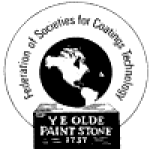- Branche: Paints & varnishes
- Number of terms: 70
- Number of blossaries: 0
- Company Profile:
Represents chemists, chemical engineers, technologists, and supervisory production personnel in the decorative and protective coatings industry and allied industries.
A synthetic polymer used in high-performance latex or water-based paints. As the paint's binder, acrylic resins enable the coating to last longer and retain its color.
Industry:
Water-thinned paint which employs acrylic resin as the majority of the binder. Other binders which may be added to reduce cost or add specific properties includestyrene, epoxy, and poly-vinyl acetate.
Industry:
Resins which have established a pre-eminent position among coating formulators, having shown superiority in such respects as color and gloss retention, alkali and oxidation (chalk) resistance, hardness, adhesive and cohesive strength, and overall film durability. Generically, resins resulting from the polymerization of derivatives of acrylicacids, including esters of acrylic acid, methacrylic acid, acrylonitrile, and their copolymers. Also known as acrylate resins.
Industry:
The ability of dry paint to remain on the surface without blistering, flaking or cracking. Adhesion is probably the single most important property of paint.
Industry:
The ability of dry paint to adhere to the surface in spite of wet conditions, is particularly important for exterior house paints.
Industry:
Process of atomization of paint by forcing it through an orifice at high pressure. The effect is often aided by the vaporization of the solvents, especially if the paint has been previously heated.
Industry:
Resins used mostly in trim paints, inside and out, although some medium duty equipment and marine enamels employ these resins as binders. Most often alkyd resins are found in vehicles employing aliphatic hydrocarbons (mineral spirits or other refined petroleum distillate) as thinner. Alkyds offer good leveling properties and cure to a relatively durable film, but tend to yellow interior and embrittle with age. Color and gloss exterior is only fair, and alkyds are highly prone to failure exterior on surfaces containing even moderate levels of moisture. Chemically, alkyds are synthetic resins formed by the condensation of polyhydric alcohols with polybasic acids. They may be regarded as complex esters. The most common polyhydric alcohol used is glycerol, and the most common polybasic acid is phthalic anhydride. Modified alkyds are those in which the polybasic acid is substituted in part by a monobasic acid, of which the vegetable oil fatty acids are typical.
Industry:
The binder cements the pigment particles into a uniform paint film and also makes the paint adhere to the surface. The nature and amount of binder determine most of the paint's performance properties -- washability, toughness, adhesion, and color retention. Acrylic polymers are the binder of choice in producing quality high-performance latex paints.
Industry:
(1) Originally, the class of paints consisting essentially of natural bitumens dissolved in organic solvents. They may or may not contain softening agents, pigments, and inorganic fillers. They are usually black or dark in color. Within recent years, the term "bituminous" has, by common usage, come to include bitumen-like products such as petroleum asphalt. (2) A low cost paint containing asphalt or coal tar, a thinner, and drying oils; used to waterproof concrete and to protect piping where bleeding of the asphalt is not a problem.
Industry:
